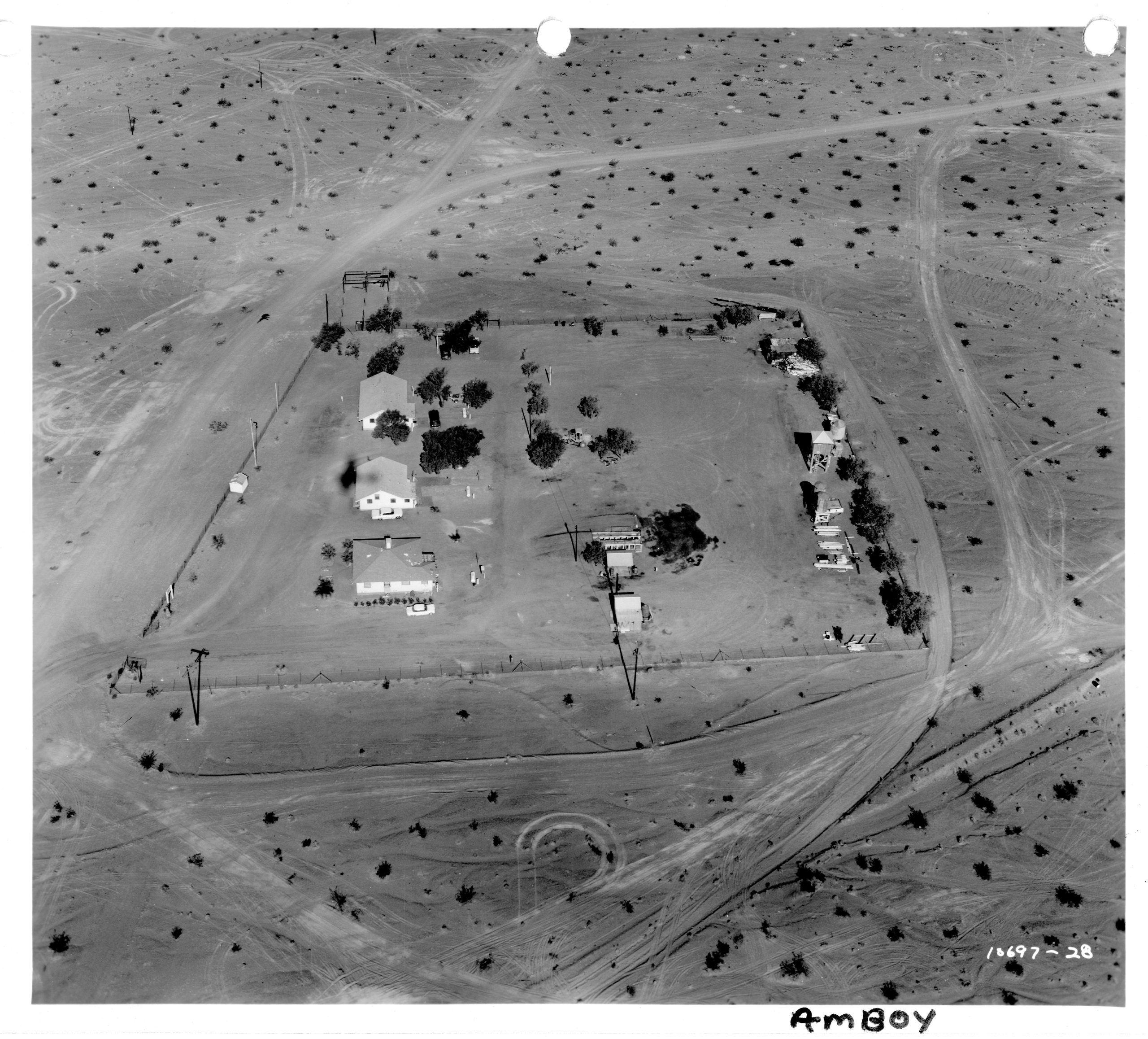Now, if you’re thinking this might be a story about the storied ‘Highwaymen’ of years long passed, you might want to read on and become elucidated a bit on southwest lore. Because this, dear friends, is a story about those desert dwellers who built and maintained the roads between Needles, California, and all points west in the great Mojave Desert and beyond.
Let us introduce to you Mr. George Robinson. Of late, a resident of Northwest Nevada, and for many years of his life, from childhood onward, one of the few brave, and often lonely souls who survived quite well in the desert, long before cell phones and satellite TV. It was–and is, after all, the desert way.
Presently in his mid-eighties and still as sharp as a NSA Cray supercomputer, George worked for the California Division of Highways and Caltrans for 39 years, mostly along the well known and under-appreciated “Alphabet Towns” that existed to provide a stopping point for the railroads in the late 19th and early 20th centuries.
Naturally, highways followed the towns that followed the trains. That is how a young boy came to be raised among the sand and lava beds between Needles and Barstow with a few side trips to the more occupied parts of the California coastal areas.
Misery for most adults? Perhaps. But possibly the ideal place for a kid to come of age, in the biggest sandbox one could imagine for a backyard.
George’s father worked out in the desert for the California Department of Highways, doing some of the early roadwork that would one day become Route 66, also known as the Mother Road. George naturally followed in his father’s bootsteps. Always wear boots in the desert; just a tip.
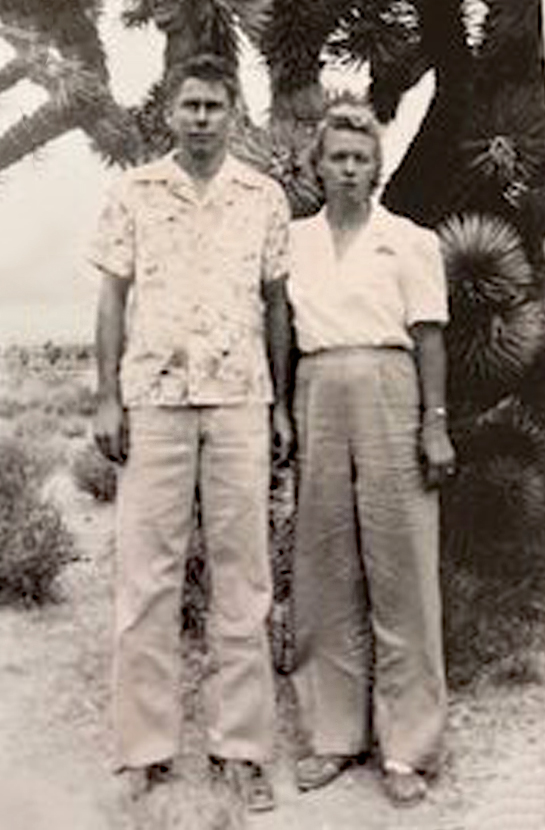
George’s Mom and Dad in Joshua Tree, CA.
At the time, the Division of Highway Maintenance area of responsibility included train stations, small airports, rest stops and, naturally, the highways. Over time, there would be sixteen California Highway Maintenance Stations with affordable housing built between the late 1920s and 1945 for employees and their families, such as it was.
George lived in Amboy, Newberry (Springs), Ludlow, Essex, Helendale and Yermo, all on Route 66. As an adult, he became acquainted with many personalities who occupied the desert communities, including Amboy’s well-known Buster Burris and Roy Crowl.
Other highway camps where George lived were Baker, Desert Center, Mountain Pass and Oasis, south of Indio.

Aerial view of former Division of Highway Maintenance Camp in Amboy, California.
“Some of the maintenance stations were built when roads was taken into the highway system. They were called camps,” George told us.
“In Newberry (Springs) there is one old house with green snow roof and a newer one. That location was sold in mid-70s, Amboy sooner. The house on your photo in Amboy on the left is newer.”
George continued, “I was Supervisor in Essex when the final piece of Interstate 40 opened, Ludlow to Mountain Springs. Then, most maintenance stations in remote locations had cheap housing to get employees to go there.”
“Desert Center and Oasis south of Indio also had houses. Hinkley had tents.” George noted that at one time, he and his siblings lived in a tent, while his parents occupied a small structure nearby.
“Helendale on 66 west of Barstow had houses. Yermo, Baker, and also in Mountain Pass on 91. Some only had a supervisor’s house,” he clarified.
“Essex and Newberry had wells with good water and a public drinking fountain out front that looked like a wishing well. You would not believe what went on in them in hot summer!”
“Do tell,” we asked. George told us, “People plugged up the drain and took baths in the water fountains in about two and a half feet of water in the basin,” unbeknownst to thirsty travelers.
“Amboy,” George reminisced, “got their water by rail car from Newberry Springs. The railroad well cistern was by tracks, also a pressure pump and tank were in yard.”
“I think state paid $25 for 10,000 gallons and the supervisor would tell you if he thought you using too much water. Whenever the pump came on there was a light on side of the tank house. There was no car washing.”
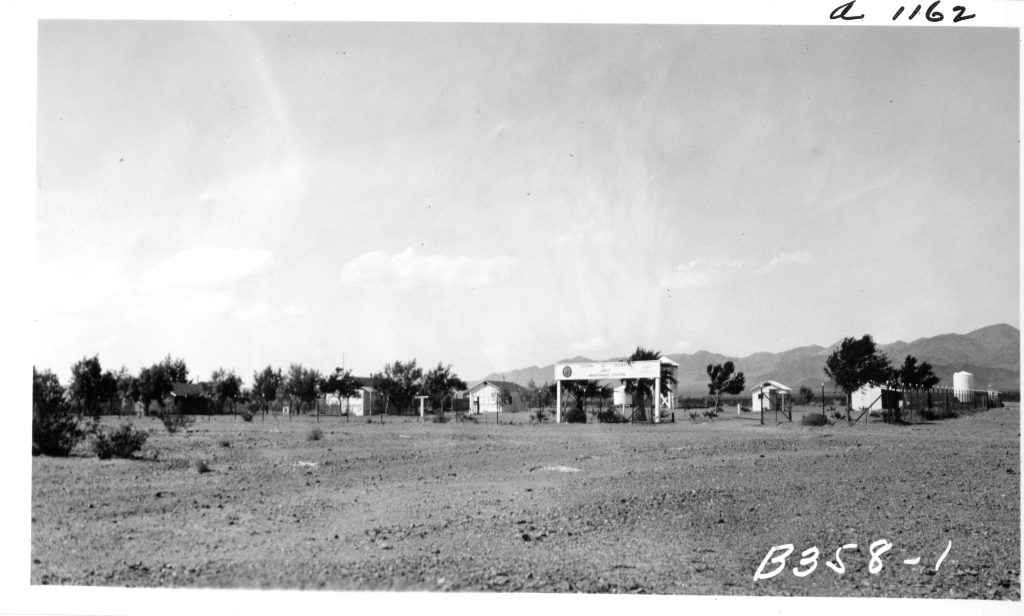
Division of Highways Maintenance Station in Amboy
These black and white photos of the Division of Highways Maintenance Station in Amboy, were provided by George Robinson’s daughter, Kim. She also emailed us photos of her grandparents and Dad.
George explained, “The house on the left is the Supervisor’s house and the one on the right is the second maintenance man’s house. I lived in third one (not in picture) during 1963 to ’65. There was a gas house where oil and other service items were kept. Also kept there was a log for gas, diesel, and oil usage.”
“There were similar maintenance stations in Newberry Springs. Essex, and Needles. I lived in three of the four mentioned, from 1963 to ’73 off and on,” George added.
Originally settled as a mining camp in 1858, the community of Amboy got its name from the Southern Pacific Railroad on December 21, 1903. Now we’ve circled back to the whole Alphabet Town subject.
Amboy was soon followed by Bolo (formerly Bombay, Bengal, Bristol) Cadiz, Danby, Essex (formerly Edson), Fenner, Goffs (formerly Blake then changed back to Goffs), Homer, Ibis, Java, and Siberia, all in alphabetical order to make them easier to remember for telegraphers and dispatchers.1.
When Santa Fe took over the lines a few years later, more stations were needed. Siam, Hartoum, Nome and Klondike were added.
Roy Crowl started with an auto repair shop, then Herman “Buster” Burris came to work for him and married Roy’s daughter, Bessie. In 1945 they built a cafe and a couple of cabins for travelers waiting to have their automobiles repaired.
Crowl began construction of a motel in 1948, still standing. Mr. Crowl died in 1971, and Buster Burris took over management of Amboy.
Roy’s Garage was a small auto repair shop originally built by Ben Benjamin and later run by Roy Crowl.2. It was east of of Bender’s Standard Station. A year or two later, Crowl built Roy’s Cafe. The garage was directly across from where Roy’s now stands.
According to George, Roy drove a 4-door DeSoto. “Back in the day, people could get permits to capture wild donkeys that freely roamed the area. Crowl was known for catching them by tossing a lasso from his Jeep,” George recalled.

Another view, Division of Highways Maintenance Station in Amboy
George’s daughter, Kim, told us, “The Amboy photos are of the State yard in Amboy. My Dad worked and lived there when he first started his State service.”
Early on in his life, George spent some years living in a rock house on Harvard Road and Highway 91 in the Mojave riverbed, twelve miles from Yermo. He noted that Yermo had a roundhouse, a train repair facility in the old style.
Good ol’ President Dwight D. Eisenhower signed the Federal-Aid Highway Act of 1956. Under the act, the federal government supplied 90 percent of funding for interstate highways, with the state paying the remaining 10 percent.

George and his family visited Joshua Tree. He is the littlest boy.
George’s family also lived in Daggett, and even Azusa, where he attended the third grade.
During his employment with the California Division of Highways, George was granted a transfer to Newberry Springs after serving a couple of years in Amboy.
“Newberry was so lush and green,” he said, compared to the dry desert he was used to. George lived on Hector Road, east of Newberry, when Newberry got its first dial-up telephone.
Before the late 1960s, many phones in the remote desert were hand-cranked party-line phones. Think of the old TV comedy, “Green Acres,” and you’ll be able to relate.
“Before then,” George said, “the phones went through the operator in Colton and everybody knew who you were talking with, and you had to yell into the phone when the connection grew too weak, “Hang up the phone!” The connection would immediately grow stronger once the eavesdropping parties hung up.
Newberry became Newberry Springs in 1967 to avoid confusion with a similar sounding town, Newbury Park, north of Los Angeles.
George remembered when the isolated town of Essex had only one hand-cranked telephone, even with the town still thriving because Route 66 was open. As we talked, we mentioned to George that I recalled driving through Essex in 1971, and using that antique phone.
“I lived in Essex for 18 months, starting in 1971,” He said, and then fondly recalled when entertainer Johnny Carson was responsible for bringing television to Essex, which had none.
The California Department of Transportation (Caltrans) was formed to unify all transportation functions under a single department in 1973.
In 1977, the whole town of 61 people Essexites was bussed to Burbank to watch the production of The Tonight Show, because Essex did not have any television reception due to mountains blocking the signal. To the town’s delight, Carson and crew took care of the problem, at least temporarily.
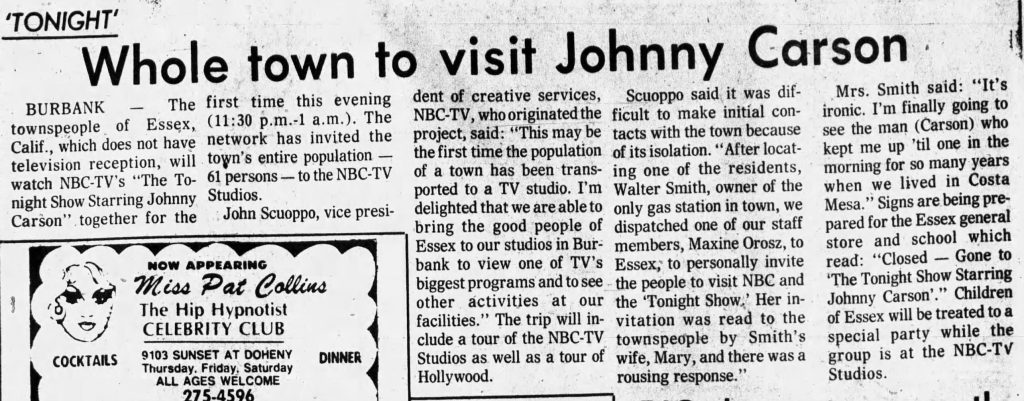
Anaheim Bulletin, March 25, 1977
Most of the houses George lived in as a kid did not have electricity or indoor plumbing. They had all manner of animals though, including chickens and livestock.
George stated the Daggett Marine Base Annex used to rent housing to civilians in the 1940s for thirty or 40 dollars a month.
“The Department of Highway Maintenance supervisors ran patrols carrying diesel, motor oil and barrels of striping paint to workers,” he said.
“They also carried corks to plug the holes after people shot at barrels along the highway.”
George worked on Route 66 in the mid 60s. He recalled, “Siberia was gone. My work partner and I took R/R Siberia siding sign and planted it in front of maintenance station in Amboy.”
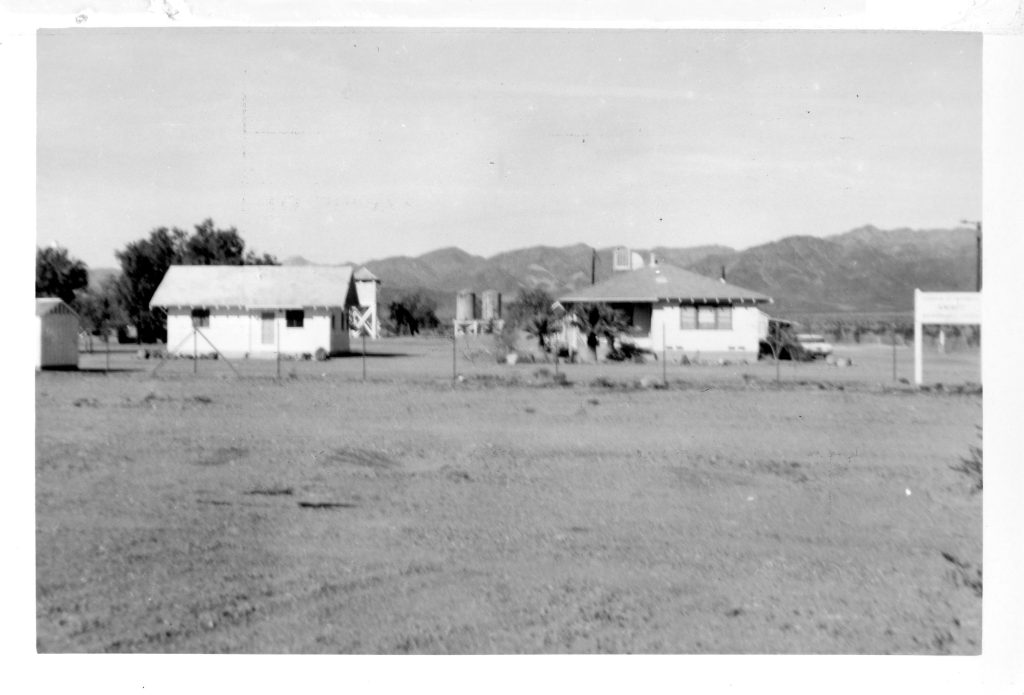
Division of Highways Maintenance Station in Amboy
George told us the last segment of Interstate 40 had to be done all at once from Ludlow to Desert Center to Mountain Springs.
The completion of Interstate 40, of course, spelled disaster for local businesses. The interstate eventually bypassed Route 66 altogether.
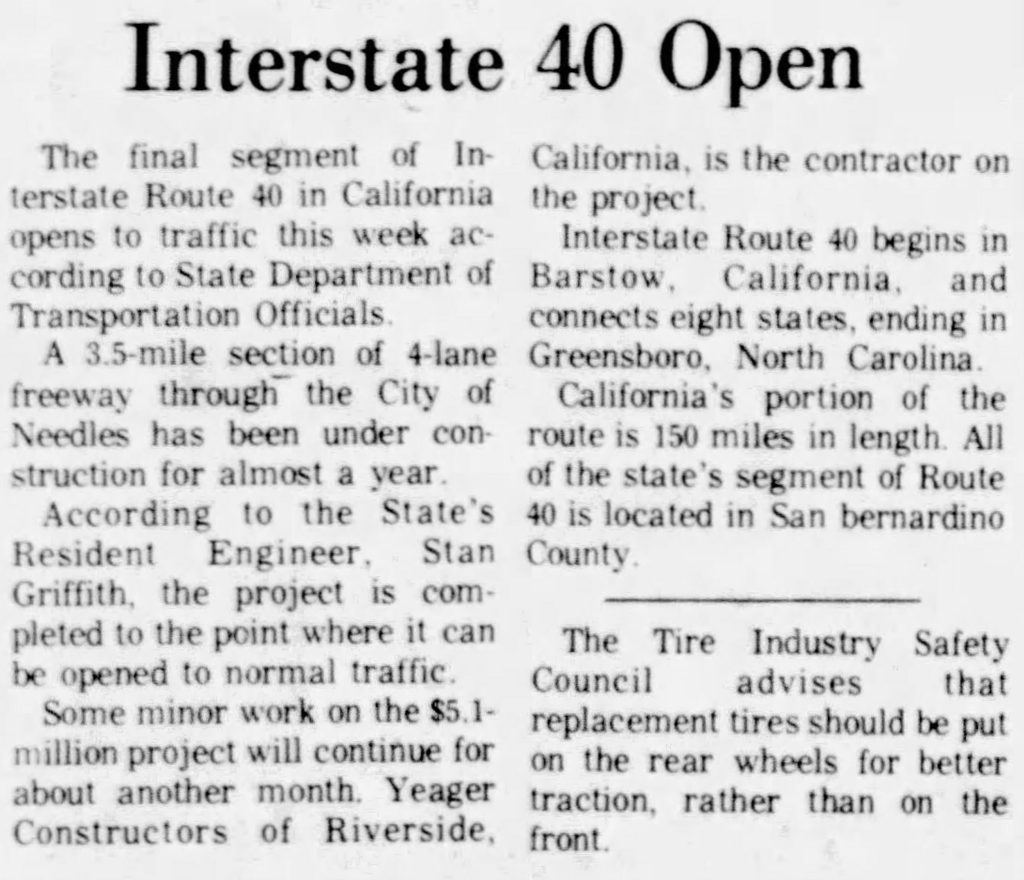
Hi Desert Star, August 16, 1973
Hurried travelers were no longer stopping at filling stations, restaurants and motels along Route 66, forcing them to shutter forever.
Some formerly popular locations became ghost towns while others were razed and disappeared. U.S. Route 66 was decommissioned in the 1980s.
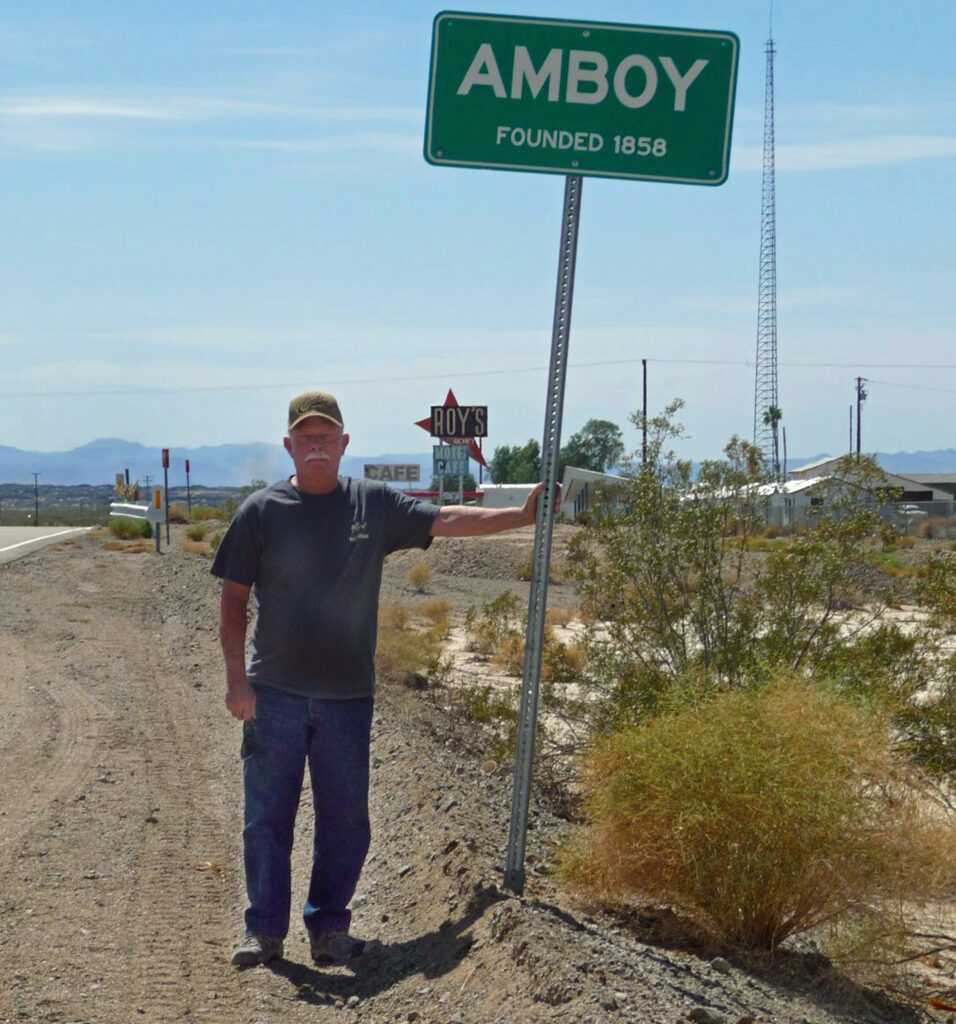
George Robinson, 2015.
Amboy continued to barely hang on by the skin of its teeth until Albert Okura, owner of the Juan Pollo restaurant chain, purchased the whole town in 2005 for $425,000 dollars.
Despite Albert’s sudden passing in 2023, Amboy is still undergoing a resurgence thanks to the diligence of his son Kyle, the Okura family and dedicated staff, town manager Kenneth Large and Miss Nicole.
George spent 18 years of his career living in Desert Center in a two bedroom, 900 square foot house.
Desert Center was founded by “Desert Steve” Ragsdale in 1921, featuring a cafe, gas station, and pool. It was also the location of the Desert Center Army Air Field and Camp Desert Center, a World War II training base for desert combat. Almost nothing remains of either.
Although most of Route 66 in the California desert may seem abandoned, its popularity still thrives. Route 66 is not just a road, it’s a slice of Americana.

Former Division of Highway Maintenance Yard in Amboy, 2015. Photo by John Earl.
Others commented, as well, “Before I retired from Caltrans, around 2011, rent for employees had risen to a point that there was little incentive to work in the remote yards.
I heard that right of way agents were using housing comps from cities like Needles, etc. to set rent for employees. I believe at least Essex and Mountain Pass were affected.” ~Steve Frasier
If you would like to share your memories about Amboy, please contact Ken@visitamboy.com if interested in sharing your story and Amboy experience.
Our appreciation to George for graciously sharing his recollections with us over the phone. Also, many thanks to his daughter, Kim, for emailing us the photos and to Steve for his comments.

Former Division of Highway Maintenance Yard in Amboy, 2015. Photo by John Earl.
Top Photo: Aerial view of former Division of Highway Maintenance Camp in Amboy, California.
References and Resources
- Schoffstall, Patricia M., Mojave Desert Dictionary, Second Ed., Mojave River Valley Museum, Barstow CA, pub. 2014.
- De Kehoe, Joe, The Silence and The Sun, Second Ed., Trails End Publishing, pub. 2012.
Visit Amboy https://visitamboy.com
Caltrans District 8 (Riverside and San Bernardino Counties) https://www.facebook.com/caltrans8
Department of Transportation Library https://dot.ca.gov/programs/transportation-library/library-collection
Department of Transportation Oral Histories https://dot.ca.gov/programs/transportation-library/short-summaries-of-oral-histories
Interstate Highway Myths https://highways.dot.gov/highway-history/interstate-system/50th-anniversary/interstate-highway-system-myths
Yermo Round House https://www.trainorders.com/discussion/read.php?11,1638110
